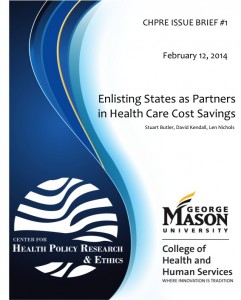Posted by CHPRE Staff
Center Activities, Hot Topics, Issue Briefs
Friday, September 19th, 2014
September 19, 2014. In this second Issue Brief of the new CHPRE series, Len Nichols, Director of the Center for Health Policy Research and Ethics, explains an essential but sometimes overlooked history of the Any Willing Provider and Freedom of Choice Laws and then reviews the arguments and evidence for and against them. In the end, Nichols offers conclusions for both sides to consider as the policy debate moves forward, or backward, or in circles, as the case may be.
Posted by CHPRE Staff
Hot Topics, Hot Topics, Issue Briefs, Policy Debates
Wednesday, February 12th, 2014

In this first Issue Brief of the new CHPRE series, Stuart Butler of the Heritage Foundation, Dave Kendall of Third Way and Len Nichols of CHPRE explain why and how policy makers can create incentives for states to engage private and federal stakeholders in health care cost containment activities that need to be jumpstarted, but likely will not without state engagement.
Posted by Terri Ann Guingab
Issue Briefs
Friday, July 30th, 2004
Executive Summary:
The Medicare Prescription Drug, Improvement and Modernization Act of 2003 (MMA) (P.L. 108-173) was designed to achieve five goals related to private Medicare Advantage (MA) health plans and the Medicare program: (1) maximize the number of beneficiaries with access to MA plans, (2) encourage MA plans to enter areas not served by MA plans today, especially rural areas, (3) promote vigorous competition among MA plans in all markets, (4) expand the range of private plan types in MA, and (5) reduce long-term growth in program outlays. A key policy decision that will affect the achievement of these goals involves selecting the number of market regions into which the nation will be divided and the geographic boundaries of those regions. While leaving this decision to the Secretary of the Department of Health and Human Services (HHS), the MMA limited the secretary’s discretion somewhat by mandating that the number of regions be no less than 10 and no greater than 50.
To encourage health plans to serve Medicare beneficiaries with regional PPO products as opposed to as a local plan, the MMA included special and temporary incentives as well as a two-year moratorium on plans initiating new local PPOs. The legislation also requires competitive bidding by MA plans, and sets out three important rules to govern the bidding process: (1) regional MA plans must bid one price for the entire region (local plans are allowed to bid one price for each county); (2) the government payment will be set equal to a benchmark premium (adjusted for relative beneficiary risk), so beneficiaries will have to pay—in addition to their usual Part B premium—the difference between the bid and the benchmark if the bid exceeds the benchmark; (3) benchmarks are determined differently for regional and local plans, and will generally not be equal for the two types of plans even though they may compete against each other in some counties. These different benchmarks could very profoundly affect market dynamics and program outcomes.
To explore the implications of the secretary’s decision in light of these rules and the central goals of the MMA, the Office of the Assistant Secretary of Planning and Evaluation (ASPE) of HHS contracted with the Center for Studying Health System Change (HSC) to conduct the analysis documented in this report. The purpose of the report, therefore, is not to make specific recommendations to ASPE about which strategy it should use in drawing MA market regions. Rather, we sought to identify and analyze tradeoffs inherent in alternative strategies. In some sense, the valuations of these tradeoffs are not economic judgments, but political ones, which are best left to policymakers, not policy analysts. We can, however, inform the policy process by articulating what some of the key implications of these judgments are, relative to the very clear goals of the MMA.
This summary reviews HSC’s approach to the analysis, the dynamics of plan competition that should be considered in drawing the MA market regions to achieve MMA goals, the scenarios that might come about as a result of these dynamics, and the pros and cons of some alternative numbers and types of market regions.
Posted by Terri Ann Guingab
Issue Briefs
Saturday, December 1st, 2001
“Simulating Health Insurance Tax Credits Using the Health Insurance Reforms Simulation Model (HIRSM),” Final report to DOL/PWBA, December 2001, (with Linda J. Blumberg, Yu-Chu Shen, and Matthew Buettgens).
Posted by Terri Ann Guingab
Issue Briefs
Monday, October 1st, 2001
Introduction:
The overarching mission of the Division of Nursing is to provide national leadership to assure an adequate supply and distribution of qualified nursing personnel to meet the health needs of the Nation. In 1998, Congress amended Title VIII of the Public Health Service Act to require the Division to develop a funding allocation methodology for its education and practice programs so that its mission could be more easily and clearly achieved. As part of Phase I of that development, the Urban Institute wrote a technical concept paper that developed and reviewed options for the funding allocation methodology (Nichols, 2000). A qualitative allocation process, one that draws upon all available data and expert judgments, was recommended and supported by the independent Funding Allocation Consultation Panel. This funding allocation methodology was designed to help the Division promote its three major goals: advanced education nursing, basic nurse education, and increased diversity in the nursing workforce. Data and quantitative methods are central to any funding allocation process. Developing an objective assessment of the nation’s evolving need for nurses is a key prerequisite to assuring an adequate supply of nursing personnel, as is comparing that assessment with estimates and projections of nursing supply. During Phase I, some in the nursing community who had supported the new funding allocation requirement were frustrated with the conclusion, explained in the final report, that current data simply cannot support the implementation of a purely quantitative allocation methodology. The purpose of this paper is to assess what the current literature can and cannot contribute to the funding allocation decisions the Division must make.
“How Many Nurses Will We Need? An Essay on Why the Current Literature Cannot Substitute for Expert Judgment,” Final report to HRSA/DON. October, 2001.
Click here to view the report.
Posted by Terri Ann Guingab
Issue Briefs
Tuesday, August 1st, 2000
“Estimating the Effects on Firms and Workers of Changing the Tax Treatment for Employer-Sponsored Health Insurance.” Final report to DOL/PWBA, August 2000 (with Linda J. Blumberg).
Posted by Terri Ann Guingab
Issue Briefs
Monday, March 1st, 1999
“Choosing Employment-Based Health Insurance Arrangements: An Application of the Health Insurance Reform Simulation Model,” Final Report to DOL/PWBA, for Contract # J-9-P-7-0044, (With Linda J. Blumberg and David Liska) (March 1999).



